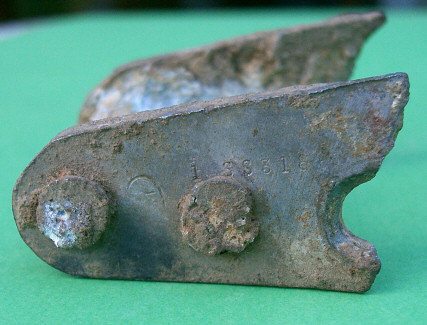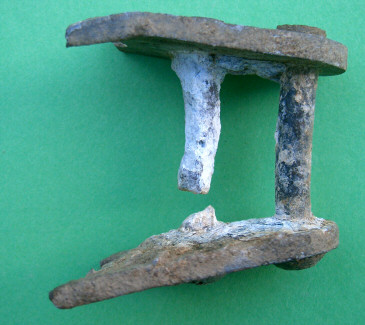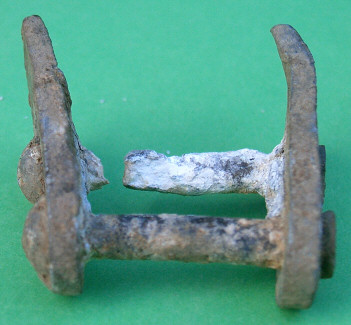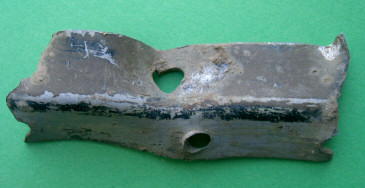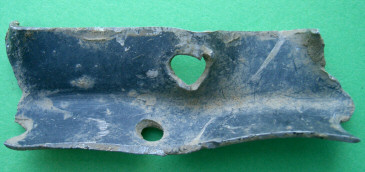 |
207 SQUADRON ROYAL AIR FORCE
HISTORY
Items from the Solly Crew Crash Site,
Lancaster EM-M LL973
22 June 1944, near Dorne
Province of Limburg, Belgium
|
There are
many images on this page so those with a slower connection
should please allow time for them to load
The following Lancaster wreckage items are
among those which were gathered from walking the crash site
field, which is between Dorne and Niel-bij-As, after the crop
had been cut and with the permission of the farmer.
They are part of the continual harvest of
ammunition, metal parts and perspex that the soil produces as
a result of cultivation and ploughing. The same is true of
many other crash sites. Items which have any kind of writing
on them, especially serial numbers, are of great interest as
it is possible that these can be identified by those with
working knowledge of the construction, servicing and
equipment of the Avro Lancaster.
According to The Lancaster File,
compiled by JJ Halley (Air Britain, 1985) this aircraft LL973
was one of a batch of 350 Lancaster Is delivered between
November 1943 and August 1944 by Armstrong Whitworth. It
arrived on No.207 Squadron at RAF Spilsby on 11th May 1944
and by the time it was lost on its 16th operational sortie
(P/O CJ Solly, Wesseling) on 22nd June 1944, it had logged
81.35 flying hours.
Three members of the Solly crew were found
dead at or very near the field:
The Bomb Aimer Sgt Eddie Chapman and Rear Gunner Sgt
Peter Loakes were taken PoW. The Flight Engineer Sgt Arthur
Barton and the Wireless Operator Sgt Frank R Haslam both
evaded capture.
Especial thanks are given to Danny
Vanstraelen-Reumers, Friend Member of 207 Squadron RAF
Association and grandson of Gerard and Helena Delsaer, the
couple who hid the Solly crew's Wireless Operator Sgt Frank R
Haslam for 13 weeks. Many of the items below were donated to
the editor by Danny, to supplement those the Haslam family
have collected on visits to the crash site. The .303 round
and item 12 were found by the owner of the field.
Raymond Glynne-Owen provided information about the aircraft's
service on 207 Squadron.
If you are able to identify any of these
items please contact the www.rafinfo.org.uk editor, Frank W Haslam
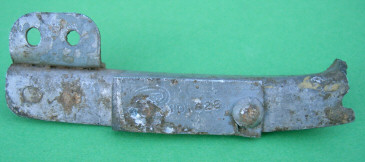
 |
item 3: two views and detailed
view below
upper view shows a manufacturer's
mark and a serial (???I?)MD 1628
dimensions: centres of the two holes are 1cm apart
(4/10")
the wedge shaped piece is 8mm (half inch) wide and
35mm (14/10") long
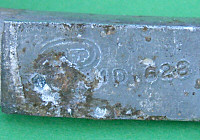
|
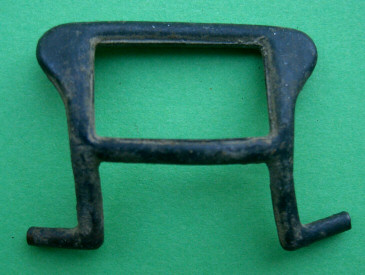 |
item 4
it has been suggested that this
might be a buckle from some kind of equipment
harness, rather than from something worn by aircrew.
serials: none
dimensions: top width 44mm (1¾"), bottom width
54mm (just over 2"): internal width 25mm
(1")
|
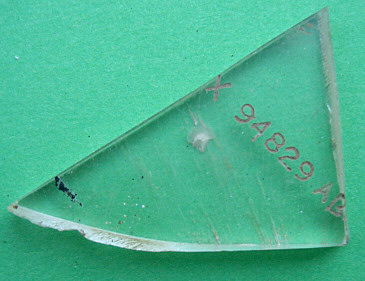 |
item 5
perspex
serial visible: X 94829 AB
dimensions: 4mm thick (between 1/10" and
2/10")
|
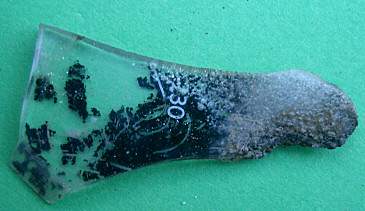 |
item 6
perspex, fire damaged
shows figures in white 230 against what appears to be
a scale gradation mark
dimensions: about 2mm thick (just under 1/10")
|
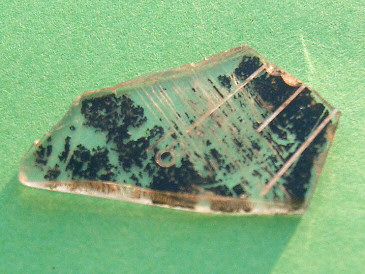 |
item 7
perspex, fire damaged
shows figures in white 18 against what appear to be
scale gradations
|
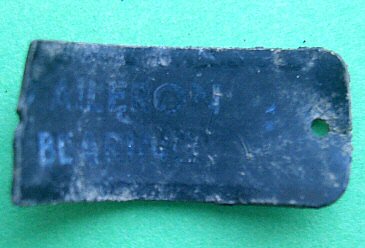 |
item 8
bent thin black painted metal
strip, with two fixing holes approx 25mm (1")
apart
faint lettering residue visible but hard to make out
top line: AILERON
bottom line: BLAR???
dimensions: 12-13mm (half inch) wide
|
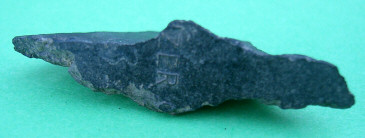
item 9, two views
hard plastic type material
marks: on image above note the word fragment IZER
serials: none
dimensions: see right - height about 25mm (1")
|
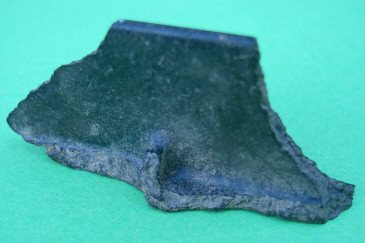 |
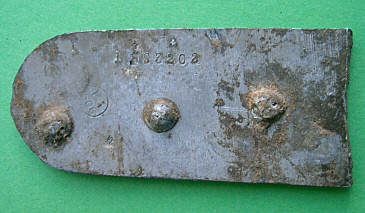 |
item 10
metal
markings: serial 1?5S3202 and below that, within a
circle, possibly PT or PI 506
dimensions: fixing centres are 20mm (¾") apart,
the item is slightly tapered down to 25mm
(1") across and is about 2mm (1/10") thick
|
 |
item 11
view above shows brown and black
painted strip of metal
with two corroded attachment points (appear to be nut
and bolt).
the left hand attachment point has
a fragment of perspex fixed to the metal
(see close up on right), suggesting that this could
have come from somewhere
such as a turret or window.
dimensions: 3cm (1.1") wide; spacing of
attachment points 8cm (3"),
thickness of perspex fragment 4mm approx (between
1/10" and 2/10")
|
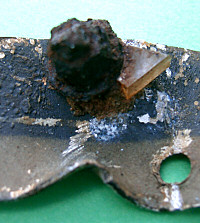 |
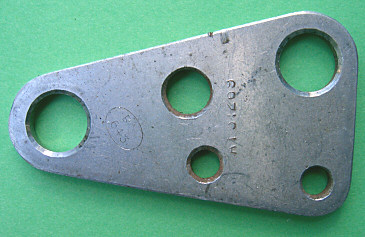 |
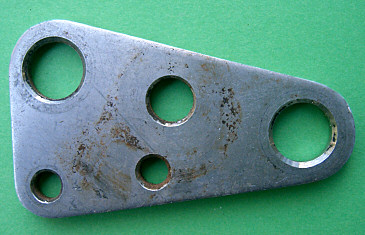 |
item 12 front and
back
presented to the Haslam family by
the owner of the field
markings: serial A 1(3?)1269 plus in an ellipse F or
E 643
dimensions: thickness 4-5mm (15/100"), top to
bottom max 43mm (17/10"), width 75mm
(29/10"): large holes 12-13mm (half inch) dia,
middle size hole 8-9mm (4/10") dia, small holes
6mm (¼") dia.
|
the reverse side shows what looks like rotational
wear in the two upper apertures on the right |
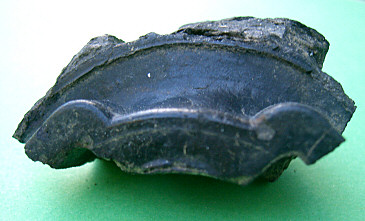
item 13 two views
appears to be a bakelite control
knob
markings: the image on the right shows 71S70
dimensions: the knurls on the knob are separated by
approx 20mm (7-8/10")
|
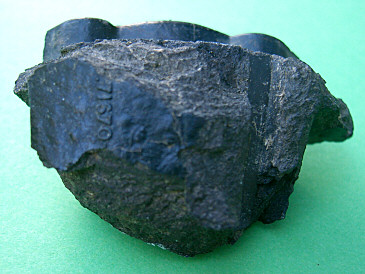 |
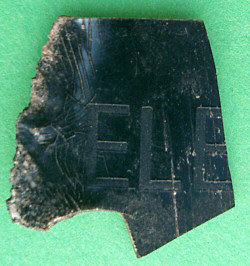 |
item 14
thin (1-2 mm) flexible plastic type
material, some fire damage
markings: the capital letters ELE can be seen
|
 |
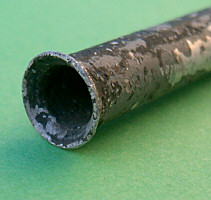 |
item 15
it is suggested that this may be an
oil pipe, indicated by the fluted end for an olive.
markings: none
dimensions: tube external diameter 10mm (4/10"),
width of flute about 12mm (45/100")
|
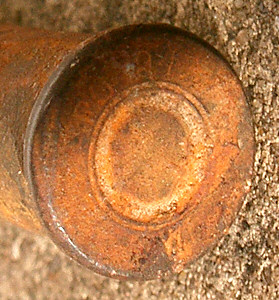 |
a .303 round seen in Belgium,
found by the owner of the field
cap markings (see left) are
difficult to make out
possibly top RO 1942, bottom WD

|
images: Haslam
page last updated 1 Dec 2005: 28 Dec 13

